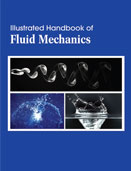Handbooks

Fluid mechanics is the study of the effects of forces and energy on liquids and gases, such as velocity, pressure, density and temperature as functions of space and time. The development of fluid dynamics has been strongly influenced by its numerous applications. Some of the fields of application to engineering, the nvironmental sciences, and the biological sciences are evident: aeronautical engineering, marine engineering, meteorology, oceanography, and the study of blood flow, the dynamics of swimming, and the flight of creatures. There are also many less immediately obvious applications. Fluid mechanics deals with the study of all fluids under static and dynamic situations. The text will be of great interest to those whose work involves or concerns fluid mechanics. A superb introductory resource, covers everything the engineer needs to know: the nature of fluids, hydrostatics, dimensional analysis, and much more.
Fluid mechanics deals with the study of fluids (in a state of rest or motion is an important subject of Civil, Mechanical and Chemical Engineering. A susbstance that flows is called as fluid. All liquid and gaseous substances are considered to be fluids. Water, oil, and others are very important in our day-to-day life as they are used for various applications. Fluid mechanics is of fundamental importance to a number of disciplines, including aerospace, chemical, civil, environmental, mechanical, and ocean engineering, as well as to climatology, geology, meteorology, and oceanography. Applications in these fields include, but are not limited to, the study of fluid forces acting on vehicles; flows in natural rivers and artificial channels and the flow of ground water; the dispersion of pollutants in the atmosphere, lakes, rivers, and oceans; the flows in the circulatory and pulmonary systems of humans and animals; the flows in pipelines that carry crude oil and natural gas over many hundreds, or even thousands, of miles from the petroleum fields of their origin to deep-water ports or refineries; the flow of molten plastics or metals filling molds in the manufacture of numerous solid parts; the flow in pumps for water distribution systems; and both hydraulic and gas turbines for power generation and propulsion. Fluid mechanics forms the basis for much of chemistry and physics, and is sometimes applied to such apparently remote fields as cosmology.
Illustrated Handbook of Fluid Mechanics covers how fluids behave and interact under various forces and in various applied situations-whether in the liquid or gaseous state or both. Flows occur in all fields of our natural and technical environment and anyone perceiving their surroundings with open eyes and assessing their significance for themselves and their fellow beings can convince themselves of the far-reaching effects of fluid flows. Without fluid flows life, as we know it, would not be possible on Earth, nor could technological processes run in the form known to us and lead to the multitude of products which determine the high standard of living that we nowadays take for granted. Without flows our natural and technical world would be different, and might not even exist at all. Flows are therefore vital. Liquids and gases are classified together as fluids because, over a wide range of situations, they have identical equations of motion and thus exhibit the same flow phenomena. The phenomena of fluid motion are governed by known laws of physics--conservation of mass, the laws of classical mechanics, and the laws of thermodynamics. These can be formulated as a set of nonlinear partial differential equations, and in principle one might hope to infer all the phenomena from these. In practice, this has not been possible; the mathematical theory is often difficult, and sometimes the equations have more than one solution, so that subtle considerations arise in deciding which one will actually apply. As a result, observations of fluid motion both in the laboratory and in nature are also essential for understanding the motion of fluids.
Illustrated Handbook of Fluid Mechanics provides the necessary techniques for proper application of fluid mechanics principles. This Handbook is intended as a Textbook for students and researchers in the areas of Civil, Mechanical and Chemical Engineering.